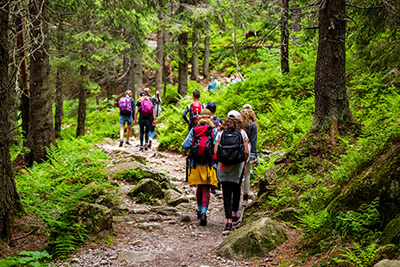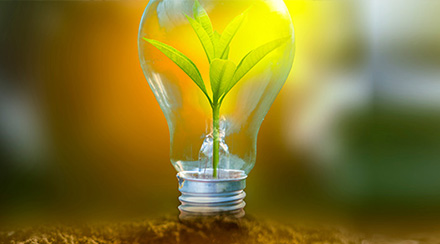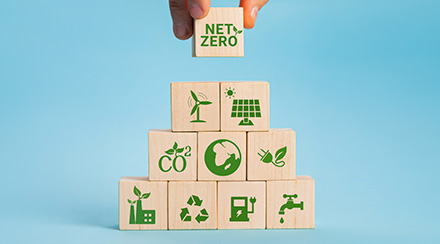What Is Wind Energy?

Modern wind turbines are capable of generating tremendous amounts of electricity, but there’s nothing new about harnessing the wind for energy. Wind filled the sails of ancient ships that sailed the seas thousands of years ago, and by the Middle Ages, windmills were a common tool for grinding grain and pumping water. The massive turbines you’ll find dotting plains and coastlines today are just the latest iteration of one of the most powerful forms of renewable energy there is.
Let’s take a closer look at how mankind has tamed the wind and used it to power a cleaner planet.
What Is Wind?
Before we get into wind energy, we should take a moment to examine what wind is and where it comes from.
Wind is the movement of air from a high-pressure air system to a low-pressure air system. When climate, weather patterns and sunlight cause an area to be cold, that creates a high-pressure system filled with dense air. And when those same factors cause another area to be warm, it creates a low-pressure system. Air naturally wants to move from areas of high pressure to those with low pressure, and the greater the difference in pressure, the faster the air moves.
How Does Wind Energy Work?
There are all sorts of ways to use wind, some of which don’t require any technology at all. When you hang fresh laundry outside on a sunny, breezy day, you’re using both wind and solar energy to conserve the electricity or gas you would use with your dryer. Some of our earliest technological innovations in wind energy, including sailing and old-fashioned windmills, are still commonly used today. Wind is a renewable resource that can be replenished, unlike fossil fuels such as coal, oil and natural gas.
But the future of high-powered wind energy is in towering wind turbines that generate electricity. The designs of these modern turbines are sophisticated and undergoing constant innovations of their own, but the underlying principle that makes them work is actually very simple.
How Do Wind Turbines Work?
The propeller-like blades of a turbine are aerodynamically designed to turn easily under the force of wind, which rotates the shaft to which they’re attached. The shaft is connected to a generator, which produces clean, renewable electricity whenever the wind blows.
This form of wind energy started gaining momentum in the early 2000s, when most electricity was produced by hydroelectric technology and fossil fuels. But in 2019, wind overtook hydroelectricity as the most common source of renewable electricity in the U.S., and has continued to expand its role as a core source of the nation’s energy supply.
How Much Energy Does a Wind Turbine Produce?

Utility-scale, land-based wind turbines vary in size, with the smallest models producing around 100 kilowatts of electricity and larger models producing several megawatts. Offshore wind turbines, which are much larger, produce even more – some offshore turbines taller than the Statue of Liberty produce more than six megawatts, and energy experts predict that 17-megawatt offshore turbines will be commonplace by 2035.
To put that in perspective, one megawatt of electricity is enough to power approximately 164 U.S. homes, according to the Solar Energy Industry Association.
Pros and Cons of Wind Energy
Like all sources of energy, there are some tradeoffs to incorporating wind-based electricity into our energy mix:
Wind Energy Advantages
- Wind is free. Once the turbines are constructed and erected, the wind takes care of the rest, free of charge. Engineers must only inspect and maintain the turbines regularly to keep them producing free electricity.
- Wind is clean. While there is a need to burn fossil fuels in the process of manufacturing, transporting and installing wind turbines, the operation of the turbines themselves produces clean energy in a way that doesn’t contribute to climate change.
- Wind can reduce our reliance on fossil fuels. The more electricity we generate from clean sources like wind, the less we have to use dirty fuels like coal, oil and natural gas. By increasing the use of renewables and decreasing the use of fossil fuels, we can help bring down atmospheric temperatures and begin to reverse climate change’s harmful effects.
- Wind helps landowners. While massive wind turbines occupy a large space in the sky, their footprint on the ground is actually quite small. This has led the wind energy industry to make mutually beneficial agreements with American farmers to place wind turbines on their wide-open land, where they’re still able to grow and harvest crops, but with extra financial assistance from wind leases.
Wind Energy Disadvantages
- Lack of energy storage capacity. The wind blows day and night, which means that sometimes wind energy production is high while electricity demand is low. To store wind energy so that it can be used during periods of peak demand, we need utility–scale battery packs. And while this technology exists and is under intensive development, it will take some time before we have the ability and raw materials needed to create energy storage at true utility scale.
- Intermittent wind speeds. It’s not easy to predict wind speeds in the short term, and therefore it’s difficult to predict how much electricity a wind turbine will generate over a period of time. Increasing our energy storage will help mitigate this problem, but intermittency is one of the biggest weak spots in both wind and solar energy.
- Environmental concerns. While wind energy does a lot to help the environment, there are some issues with large wind turbines, especially when it comes to wildlife. Birds can be killed if and when they fly into the path of turbine blades, and sound frequencies generated by turbines may be a deterrent to wildlife on the ground, potentially disrupting their habitats. Additionally, wind turbines can't be recycled.
Looking for Something Specific?
Select a category to find resources for topics that interest you.
Select Category

Related Articles:

What Are Carbon Offsets?
Carbon offsets help account for the carbon emissions produced by your daily activities. These offsets go toward projects that have a positive impact on the environment, like reforestation or renewable energy production.
Read Article
What Is Renewable Energy, or Clean Energy?
It’s easy to think of renewable energy as cutting edge; we often associate it with solar panels and wind farms, and consider it to be the future of energy production. But this is only partially true.
Read Article
What is a Carbon Footprint and How to Reduce It
We all know some basic steps we can take to safeguard the environment, but some of the most significant changes we can make involve the way we use energy at home.
Read ArticleWhat Is Wind Energy?
Modern wind turbines are capable of generating tremendous amounts of electricity, but there’s nothing new about harnessing the wind for energy. Wind filled the sails of ancient ships that sailed the seas thousands of years ago, and by the Middle Ages, windmills were a common tool for grinding grain and pumping water. The massive turbines you’ll find dotting plains and coastlines today are just the latest iteration of one of the most powerful forms of renewable energy there is.
Let’s take a closer look at how mankind has tamed the wind and used it to power a cleaner planet.
What Is Wind?
Before we get into wind energy, we should take a moment to examine what wind is and where it comes from.
Wind is the movement of air from a high-pressure air system to a low-pressure air system. When climate, weather patterns and sunlight cause an area to be cold, that creates a high-pressure system filled with dense air. And when those same factors cause another area to be warm, it creates a low-pressure system. Air naturally wants to move from areas of high pressure to those with low pressure, and the greater the difference in pressure, the faster the air moves.
How Does Wind Energy Work?
There are all sorts of ways to use wind, some of which don’t require any technology at all. When you hang fresh laundry outside on a sunny, breezy day, you’re using both wind and solar energy to conserve the electricity or gas you would use with your dryer. Some of our earliest technological innovations in wind energy, including sailing and old-fashioned windmills, are still commonly used today. Wind is a renewable resource that can be replenished, unlike fossil fuels such as coal, oil and natural gas.
But the future of high-powered wind energy is in towering wind turbines that generate electricity. The designs of these modern turbines are sophisticated and undergoing constant innovations of their own, but the underlying principle that makes them work is actually very simple.
How Do Wind Turbines Work?
The propeller-like blades of a turbine are aerodynamically designed to turn easily under the force of wind, which rotates the shaft to which they’re attached. The shaft is connected to a generator, which produces clean, renewable electricity whenever the wind blows.
This form of wind energy started gaining momentum in the early 2000s, when most electricity was produced by hydroelectric technology and fossil fuels. But in 2019, wind overtook hydroelectricity as the most common source of renewable electricity in the U.S., and has continued to expand its role as a core source of the nation’s energy supply.
How Much Energy Does a Wind Turbine Produce?
Utility-scale, land-based wind turbines vary in size, with the smallest models producing around 100 kilowatts of electricity and larger models producing several megawatts. Offshore wind turbines, which are much larger, produce even more – some offshore turbines taller than the Statue of Liberty produce more than six megawatts, and energy experts predict that 17-megawatt offshore turbines will be commonplace by 2035.
To put that in perspective, one megawatt of electricity is enough to power approximately 164 U.S. homes, according to the Solar Energy Industry Association.
Pros and Cons of Wind Energy
Like all sources of energy, there are some tradeoffs to incorporating wind-based electricity into our energy mix:
Wind Energy Advantages
- Wind is free. Once the turbines are constructed and erected, the wind takes care of the rest, free of charge. Engineers must only inspect and maintain the turbines regularly to keep them producing free electricity.
- Wind is clean. While there is a need to burn fossil fuels in the process of manufacturing, transporting and installing wind turbines, the operation of the turbines themselves produces clean energy in a way that doesn’t contribute to climate change.
- Wind can reduce our reliance on fossil fuels. The more electricity we generate from clean sources like wind, the less we have to use dirty fuels like coal, oil and natural gas. By increasing the use of renewables and decreasing the use of fossil fuels, we can help bring down atmospheric temperatures and begin to reverse climate change’s harmful effects.
- Wind helps landowners. While massive wind turbines occupy a large space in the sky, their footprint on the ground is actually quite small. This has led the wind energy industry to make mutually beneficial agreements with American farmers to place wind turbines on their wide-open land, where they’re still able to grow and harvest crops, but with extra financial assistance from wind leases.
Wind Energy Disadvantages
- Lack of energy storage capacity. The wind blows day and night, which means that sometimes wind energy production is high while electricity demand is low. To store wind energy so that it can be used during periods of peak demand, we need utility–scale battery packs. And while this technology exists and is under intensive development, it will take some time before we have the ability and raw materials needed to create energy storage at true utility scale.
- Intermittent wind speeds. It’s not easy to predict wind speeds in the short term, and therefore it’s difficult to predict how much electricity a wind turbine will generate over a period of time. Increasing our energy storage will help mitigate this problem, but intermittency is one of the biggest weak spots in both wind and solar energy.
- Environmental concerns. While wind energy does a lot to help the environment, there are some issues with large wind turbines, especially when it comes to wildlife. Birds can be killed if and when they fly into the path of turbine blades, and sound frequencies generated by turbines may be a deterrent to wildlife on the ground, potentially disrupting their habitats. Additionally, wind turbines can't be recycled.
Looking for Something Specific?
Select a category to find resources for topics that interest you.
Select Category

Related Articles:

What Are Carbon Offsets?
Carbon offsets help account for the carbon emissions produced by your daily activities. These offsets go toward projects that have a positive impact on the environment, like reforestation or renewable energy production.
Read Article
What Is Renewable Energy, or Clean Energy?
It’s easy to think of renewable energy as cutting edge; we often associate it with solar panels and wind farms, and consider it to be the future of energy production. But this is only partially true.
Read Article
What is a Carbon Footprint and How to Reduce It
We all know some basic steps we can take to safeguard the environment, but some of the most significant changes we can make involve the way we use energy at home.
Read Article






